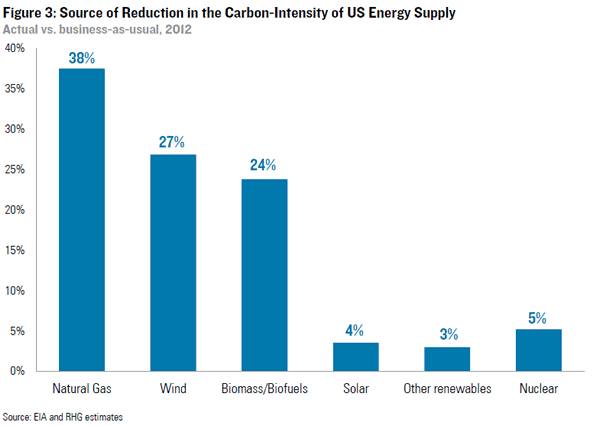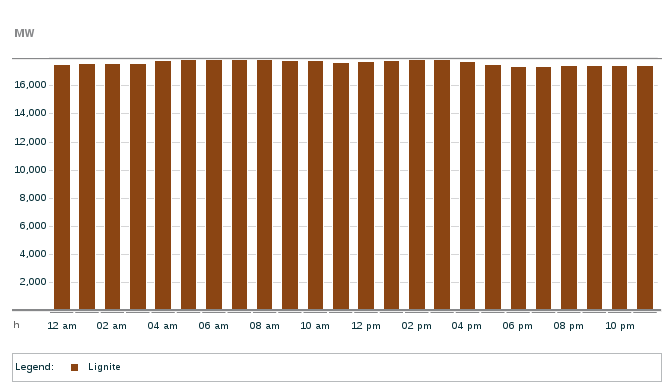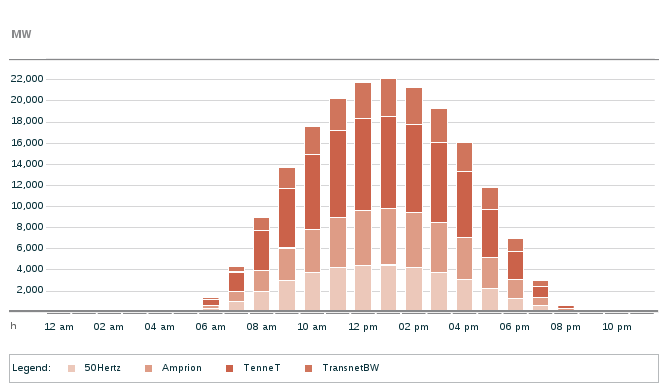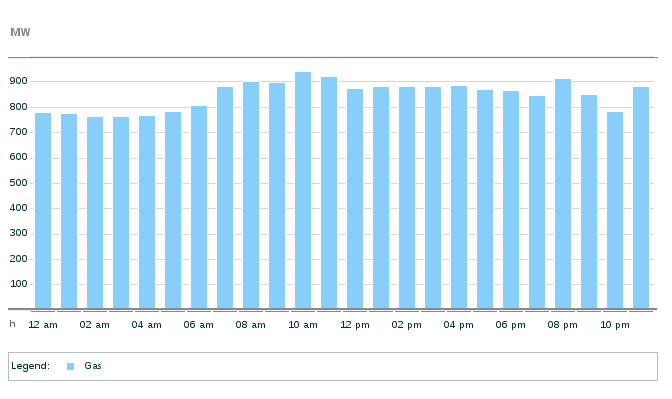How much are emissions reduced by renewables?
A new study has got some attention this week, claiming that shale gas had reduced emissions less than people had thought, and that renewables played a bigger role than perceived. The claims in the study can be summarized in the graph below.
Essentially natural gas has reduced emissions only 22%. However, their numbers, and assumptions, don’t stack up very well. Let’s consider why.
Here is their basic argument:
Coal’s market share declined from 50% in 2008 to a multi-decade low of 33% in April of last year. Natural gas was the biggest winner, growing from 20% of power generation in 2008 to more than 30% during 2012. But renewables played an important role as well. In 2005, renewables accounted for 7.9% of US power generation. During the first ten months of 2012, they accounted for 11.4%. And while one kWh of natural gas-fired generation emits roughly half as much CO2 as a kWh of coal-fired power, renewables emit no CO2 so each kWh of additional generation delivers a bigger emission reduction punch.
So, we have a bunch of things changing in the last few years. Their baseline year however is 2005, so comparing coal and gas in 2008 with coal and gas in 2012, and then suddenly compare renewables in 2005 with renewables in 2012 does not make a great deal of sense. Let’s make a meaningful comparison.
The actual percentages of electricity from each source can be found here.
- Coal goes from 49.6% to 37.4% of total production between 2005 and 2012. A 12.2% decline
- Gas goes from 18.8% to 30.3%. A 11.6% increase.
- Non-hydro renewables go from 2.2% to 5.4%. A 3.2% increase.
So, how much CO2 did gas and wind and solar save? This is a counter factual, so we need to ask what would have been burned instead of gas and renewables. Let’s assume, as they do, that it would have been coal. As the authors of the report say gas emits roughly half as much CO2 as coal, while renewables emit close to zero. The percentage of electricity from gas has gone up 11.6%, while non-hydro renewables have gone up by 3.2%. Some basic arithmetic would indicate that gas has thus saved 80% more CO2 than wind and solar, and not the 22% that the study claims.
So, they appear to be a reasonable bit out, and possibly even more. As Alex Trembeth pointed out in a Twitter conversation assuming that wind or solar are replacing nothing coal is a very questionable assumption, suggesting that wind and solar are mostly just displacing gas.
Let’s consider why this is the case. A simplified explanation of how an electricity grid works is this. Electricity demand varies throughout the day and year. There are basically enough power plants lying around to meet the maximum annual demand, which in most countries is around 6 or 7 pm on a cold winter night. The actual electricity mix at any particular time is driven by how cheap each source of electricity is. Take yesterday in Germany. Wind power was close to zero all day, so in essence it was almost an entirely non-renewable system.
This is total demand:
Running costs of nuclear power plants are very low and Germany, as most countries do, just runs them at 100% all of the time:
Lignite is very similar to nuclear, though coal output is a bit lower at night:
Gas however increases massively during the day.

In essence, when demand is high you turn on the gas plants. And when demand goes down you turn the gas plants off. Fuel costs are far more important in gas plants, so they prefer the price of electricity demand to be higher before firing them up, which happens when demand rises.
An alternative way of looking at wind and solar are not as electricity providers, but as demand reducers for non-renewable power sources. So, we can view a particularly windy day as one with lower demand. In Germany, gas will be displaced first, and then coal. However, if there is enough wind or solar on the grid it will displace both. Let’s consider the 25th May 2012, when German solar power hit a record high. This is solar that day:
As expected this results in gas not being ramped up during the day, as it was in earlier days that week:
22 GW of solar however is more power than Germany’s entire gas fleet can supply, so as expected the solar is also eating in to coal power:
Lignite and uranium plants, however, aren’t really impacted by solar:
So, I hope I have convinced you that saying that wind power is replacing coal 1-1 is rather simplistic, and probably deeply misleading.
What should we assume wind is displacing in America? At this stage we should move from considering Germany to considering the UK. The UK’s coal and gas mix is much more similar to the US’s, and it’s renewable energy is also more similar. Does wind displace coal or gas in the UK? It appears that it’s more or less entirely a 1 for 1 replacement of wind for gas. Chris Goodall and Mark Lynas ran the numbers here, concluding that:
“the exchange rate is about one for one: a megawatt hour of wind typically meant the UK grid used one less megawatt hour of gas-derived electricity.”
So, in the UK each additional kWh of gas and wind currently reduce carbon emissions by a very similar amount.
Back to this post’s question: how much CO2 is saved per kWh of wind and solar? At this point I will disappoint the reader by saying I don’t have a simple answer to the question. The key thing to recognise here is that this is not a simple equation. It is dependent on a wide range of factors: how much renewable energy is on the grid, levels of coal and gas, relative costs of coal and gas, and so on. And as a recent paper shows this equation is not the same in each region of the United States (h/t Costas Samaras). But one thing is clear: an assumption that wind and solar only displace coal is divorced from the basic realities of electricity generation.
Based on what I know, I suspect wind and solar are largely only displacing gas in America, but the question deserves a little more attention. The question could be answer quite easily with hourly electricity generation data by fuel type for all of America, which I cannot seem to find. If someone knows if this exists, please let me know and I can try to put a harder number to the emissions saved by renewables.
17 thoughts on “How much are emissions reduced by renewables?”
Comments are closed.









February 17, 2013 at 4:51 pm
A very nice post and thanks for the h/t. The takeaway, as you said is “The key thing to recognise here is that this is not a simple equation.” In the U.S. wind power is often bid into wholesale markets at $0/MWh, meaning it gets dispatched almost all the time it is producing (with some exceptions). So the emissions displaced by wind are: [the emissions of the marginal generator in the system not dispatched for each block of time wind is producing, summed over all wind generation over the year] – [any additional flexible generation balancing emissions required to maintain system balance from variable generation, summed over the course of the year]. These are knowable numbers, but vary across the U.S. in both space and time. Coal is the marginal fuel in many U.S. areas overnight, so just as the answer is not “it displaces coal”, it’s also not “it displaces gas”. An additional challenge is that the marginal fuel is often a less efficient coal or gas plant (e.g. a CT vs. NGCC) than one might otherwise assume. All of these issues, coupled with different levels of data available in some U.S. regions, result in most studies bounding the result – providing one emissions savings if coal is displaced, and a lower factor if gas is displaced. The answer, is somewhere between these two. This approach is reasonable, and can still inform policy. Our work on “Life Cycle Assesssment an Grid Electricity: What Do We Know and What Can We Know”, touched on some of this: http://pubs.acs.org/doi/abs/10.1021/es9017909.
LikeLike
February 18, 2013 at 9:44 am
All good stuff – thanks for the post. If you combine this with the paper by Richard York, “Do alternative energy sources displace fossil fuel?” Nature Climate Change Letters, March 2012 – it all gets even more challenging/depressing. He sets out to demonstrate that over the last 50 years, 1 unit of non-fossil generation has only displaced less than 1/10th of a unit of fossil generated electricity. Would love someone to demolish this argument !!
LikeLike
February 18, 2013 at 9:48 am
Robin.
Could you please provide a link to the paper? If you want to respond then don’t require them to have to find the paper.
Also, most of the non fossil fuel power over the last 50 years had been nuclear and hydro, not wind or solar. It’s far from clear what your comment actually means.
LikeLike
February 18, 2013 at 7:24 pm
This appears to be the referenced article (overview is given, but pay to view): http://www.nature.com/nclimate/journal/v2/n6/abs/nclimate1451.html
LikeLike
February 18, 2013 at 1:12 pm
Nice post. As you point out, there is no simple answer for emissions savings per MWh of e.g. wind generation. The answer can depend on thermal fuel mix, wind penetration, power spectrum of wind generation, grid constraints etc.
You might be interested in this study I did for the irish grid in 2011. High wind penetration and availability of good quality data mean that co2 savings can be found empirically with reasonable confidence. The answer in that case was wind power co2 savings of 0.28tCO2/MWh (280gCO2/kWh).
http://joewheatley.net/how-much-co2-does-wind-power-save/
LikeLike
February 18, 2013 at 10:34 pm
I agree completely with you that the answer is far more complex than the simple assumption that renewables replaces coal, however comparing the US and the UK is not as straightforward as you suggest.
Firstly whilst the generation mix might be similar the merit order is greatly different. In the US with gas at $3/mmBTU, gas CCGT is far cheaper than coal fired generation – hence the significant switch from coal to gas. In the UK it is very different. Although it depends on power station efficiency, for gas CCGT to compete with coal in the UK, gas prices would have to drop to 36ppt – and they have been 55-65ppt over the last year. In the UK it is no surprise that gas is dropping off the merit order, pretty much all fuels out compete it..
Secondly the US is far from one electricity and gas market. Huge constraints prevent proper arbitrage of gas and electricity (and coal to some extent). It is completely correct to suggest that in Texas, where gas is very cheap, and there has been significant growth of renewables, then it is almost certainly gas generation which is being substituted by renewables, but the story across the US is less certain.
Electricity prices reveal a great deal about the merit order. You can play “spot the windy day in Germany” by looking at daily EEX spot prices. You get an excellent hit rate!
LikeLike
February 18, 2013 at 10:39 pm
Mark
Did you actually read my final two paragraphs? Or did you make this comment without reading the entire post properly?
LikeLike
February 19, 2013 at 3:37 am
“There are basically enough power plants lying around to meet the maximum annual demand, which in most countries is around 6 or 7 pm on a cold winter night.”
Always thought max demand was the hottest part of a day in the summer. Where can I find more info on this?
LikeLike
February 19, 2013 at 1:00 pm
Joe
That is the case in most of the US, as far as I know. As far as I know outside the US hardly any countries have a summer peak. I think Italy is the only European country with one.
You can get electricity generation data for different countries in the data section of this blog.
https://carboncounter.wordpress.com/energy-and-emissions-data-sourcess/
LikeLike
February 27, 2013 at 4:17 am
What is the general reason for this?
LikeLike
February 19, 2013 at 1:06 pm
Funny that the question if “shale gas had reduced emissions less than people had thought, and that renewables played a bigger role than perceived” is answered with energy data from Germany – where no shale gas is in play. As my favorite blogger Craig Morris puts it:
“As of this morning, no one was able to provide this data [that Robert Wilson asked for] – probably because it doesn’t exist.
Germany is simultaneously attempting to switch to renewables, phase out nuclear, and ramp down coal, with gas to be used in the interim. The plan is more or less working, but Germany is not hiding its shortcomings; rather, it publishes more detailed statistics than almost any other country, allowing those who wish to keep up with the data to publicly scrutinize its failures.
In other words, carbon counters can bash Germany because the Germans provide the damning data themselves. The proper conclusion should be that German proponents of the energy transition and Anglo carbon counters share the same goals, not that Germany is on the wrong path.” (http://www.renewablesinternational.net/german-bashing-with-and-without-data/150/537/60647/)
LikeLike
February 19, 2013 at 2:08 pm
ArneJJ
As I have said before you are nothing but a propagandist. The fact that a day ago on Twitter you called this a thoughtful piece of analysis, and now come on here and accuse me of Germany bashing simply underlines this fact.
I could explain how you and Craig Morris are misrepresenting this post, but I really don’t think it would be worth my time.
LikeLike
February 19, 2013 at 7:29 pm
Great post.
Dieter Helm (The Carbon Crunch p80-82) points out that if the proportion of wind energy increases, this makes gas prices more expensive and more volatile. If gas power stations can’t rely on security of demand, they can’t contract to buy regular supplies of gas at favorable prices but have to buy short term supplies when the wind drops.
LikeLike
February 22, 2013 at 3:45 am
[…] best I’ve got right now. Those more in the know say that renewable energy like solar will most frequently replace natural gas production, rather than coal or nuclear, as gas is easier to cycle on and off. I’m not sure whether […]
LikeLike
February 26, 2013 at 10:28 pm
Finally got around to reading this, and it was very much worth it. I think my favourite to date. It is fascinating to think just how different the answer can be in different places. Spain must be interesting as wind dominates generation when it is windy these days, would be largely displacing gas there i guess
LikeLike
August 4, 2014 at 7:05 pm
“assuming that wind or solar are replacing nothing coal is a very questionable assumption” — I think there is a typo here? Great post, well done.
LikeLike
August 4, 2014 at 7:34 pm
Thanks.
I am a typically bad proof-reader. If I know what a sentence I have written is supposed to say, then I am somewhat incapable of noticing when it does not say what it is supposed to say.
LikeLike